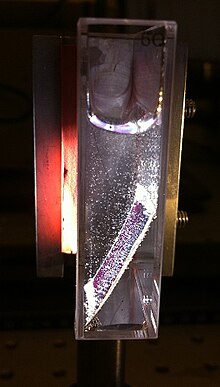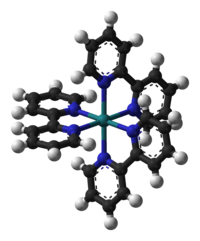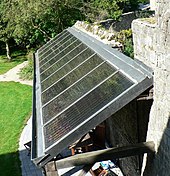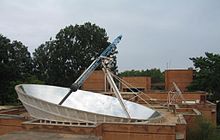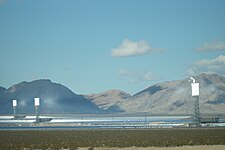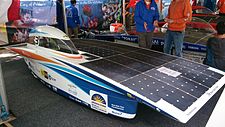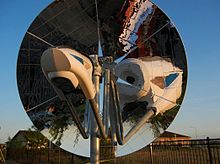A
sample of a photoelectric cell in a lab environment. Catalysts are
added to the cell, which is submerged in water and illuminated by
simulated sunlight. The bubbles seen are oxygen (forming on the front of
the cell) and hydrogen (forming on the back of the cell).
Artificial photosynthesis is a chemical process that replicates the natural process of photosynthesis, a process that converts sunlight, water, and carbon dioxide into carbohydrates and oxygen; as an imitation of a natural process it is biomimetic.
The term, artificial photosynthesis, is commonly used to refer to any
scheme for capturing and storing the energy from sunlight in the
chemical bonds of a fuel (a solar fuel). Photocatalytic water splitting converts water into hydrogen and oxygen, and is a major research topic of artificial photosynthesis. Light-driven carbon dioxide reduction is another process studied, that replicates natural carbon fixation.
Research of this topic includes the design and assembly of devices for the direct production of solar fuels, photoelectrochemistry and its application in fuel cells, and the engineering of enzymes and photoautotrophic microorganisms for microbial biofuel and biohydrogen production from sunlight.
Overview
The photosynthetic reaction can be divided into two half-reactions of oxidation and reduction, both of which are essential to producing fuel.
In plant photosynthesis, water molecules are photo-oxidized to release
oxygen and protons. The second phase of plant photosynthesis (also known
as the Calvin-Benson cycle) is a light-independent reaction that converts carbon dioxide into glucose (fuel). Researchers of artificial photosynthesis are developing photocatalysts
that are able to perform both of these reactions. Furthermore, the
protons resulting from water splitting can be used for hydrogen
production. These catalysts must be able to react quickly and absorb a large percentage of the incident solar photons.
Natural (left) versus artificial photosynthesis (right)
Whereas photovoltaics
can provide energy directly from sunlight, the inefficiency of fuel
production from photovoltaic electricity (indirect process) and the fact
that sunshine is not constant throughout the day sets a limit to its
use.
One way of using natural photosynthesis is for the production of a biofuel,
which is an indirect process that suffers from low energy conversion
efficiency (due to photosynthesis' own low efficiency in converting
sunlight to biomass), the cost of harvesting and transporting the fuel,
and conflicts due to the increasing need of land mass for food production.
The purpose of artificial photosynthesis is to produce a fuel from
sunlight that can be stored conveniently and used when sunlight is not
available, by using direct processes, that is, to produce a solar fuel.
With the development of catalysts able to reproduce the major parts of
photosynthesis, water and sunlight would ultimately be the only needed
sources for clean energy production. The only by-product would be
oxygen, and production of a solar fuel has the potential to be cheaper
than gasoline.
One process for the creation of a clean and affordable energy supply is the development of photocatalytic water splitting under solar light. This method of sustainable hydrogen production is a major objective for the development of alternative energy systems.
It is also predicted to be one of the more, if not the most, efficient ways of obtaining hydrogen from water.
The conversion of solar energy into hydrogen via a water-splitting
process assisted by photosemiconductor catalysts is one of the most
promising technologies in development. This process has the potential for large quantities of hydrogen to be generated in an ecologically sound manner. The conversion of solar energy into a clean fuel (H2) under ambient conditions is one of the greatest challenges facing scientists in the twenty-first century.
Two methods are generally recognized for the construction of solar fuel cells for hydrogen production:
- A homogeneous system is one such that catalysts are not compartmentalized, that is, components are present in the same compartment. This means that hydrogen and oxygen are produced in the same location. This can be a drawback, since they compose an explosive mixture, demanding gas product separation. Also, all components must be active in approximately the same conditions (e.g., pH).
- A heterogeneous system has two separate electrodes, an anode and a cathode, making possible the separation of oxygen and hydrogen production. Furthermore, different components do not necessarily need to work in the same conditions. However, the increased complexity of these systems makes them harder to develop and more expensive.
Another area of research within artificial photosynthesis is the
selection and manipulation of photosynthetic microorganisms, namely
green microalgae and cyanobacteria, for the production of solar fuels. Many strains are able to produce hydrogen naturally, and scientists are working to improve them. Algae biofuels such as butanol and methanol are produced both at laboratory and commercial scales. This method has benefited from the development of synthetic biology, which is also being explored by the J. Craig Venter Institute to produce a synthetic organism capable of biofuel production. In 2017, an efficient process was developed to produce acetic acid from carbon dioxide using "cyborg bacteria".
History
Artificial photosynthesis was first anticipated by the Italian chemist Giacomo Ciamician during 1912. In a lecture that was it later published in Science he proposed a switch from the use of fossil fuels
to radiant energy provided by the sun and captured by technical
photochemistry devices. In this switch he saw a possibility to lessen
the difference between the rich north of Europe and poor south and
ventured a guess that this switch from coal to solar energy would "not be harmful to the progress and to human happiness."
During the late 1960s, Akira Fujishima discovered the photocatalytic properties of titanium dioxide, the so-called Honda-Fujishima effect, which could be used for hydrolysis.
The Swedish Consortium for Artificial Photosynthesis, the first
of its kind, was established during 1994 as a collaboration between
groups of three different universities, Lund, Uppsala and Stockholm, being presently active around Lund and the Ångström Laboratories in Uppsala. The consortium was built with a multidisciplinary approach to focus on learning from natural photosynthesis and applying this knowledge in biomimetic systems.
Research of artificial photosynthesis is experiencing a boom at the beginning of the 21st century. During 2000, Commonwealth Scientific and Industrial Research Organisation (CSIRO) researchers publicized their intent to emphasize carbon dioxide capture and its conversion to hydrocarbons. In 2003, the Brookhaven National Laboratory announced the discovery of an important intermediate part of the reduction of CO2 to CO (the simplest possible carbon dioxide reduction reaction), which could result in better catalysts.
One of the disadvantages of artificial systems for
water-splitting catalysts is their general reliance on scarce, expensive
elements, such as ruthenium or rhenium. During 2008, with the funding of the United States Air Force Office of Scientific Research, MIT chemist and director of the Solar Revolution Project Daniel G. Nocera
and postdoctoral fellow Matthew Kanan attempted to circumvent this
problem by using a catalyst containing the cheaper and more abundant
elements cobalt and phosphate.
The catalyst was able to split water into oxygen and protons using
sunlight, and could potentially be coupled to a hydrogen gas producing
catalyst such as platinum. Furthermore, while the catalyst broke down
during catalysis, it could self-repair. This experimental catalyst design was considered a major improvement by many researchers.
Whereas CO is the prime reduction product of CO2, more complex carbon compounds are usually desired. During 2008, Andrew B. Bocarsly
reported the direct conversion of carbon dioxide and water to methanol
using solar energy in a very efficient photochemical cell.
While Nocera and coworkers had accomplished water splitting to
oxygen and protons, a light-driven process to produce hydrogen is
desirable. During 2009, the Leibniz Institute for Catalysis reported
inexpensive iron carbonyl complexes able to do just that. During the same year, researchers at the University of East Anglia
also used iron carbonyl compounds to achieve photoelectrochemical
hydrogen production with 60% efficiency, this time using a gold
electrode covered with layers of indium phosphide to which the iron complexes were linked. Both of these processes used a molecular approach, where discrete nanoparticles are responsible for catalysis.
Visible light water splitting with a one piece multijunction cell
was first demonstrated and patented by William Ayers at Energy
Conversion Devices during 1983.
This group demonstrated water photolysis into hydrogen and oxygen, now
referred to as an "artificial leaf" or "wireless solar water splitting"
with a low cost, thin film amorphous silicon multijunction cell immersed
directly in water. Hydrogen evolved on the front amorphous silicon
surface decorated with various catalysts while oxygen evolved from the
back metal substrate which also eliminated the hazard of mixed
hydrogen/oxygen gas evolution. A Nafion membrane above the immersed cell
provided a path for proton transport. The higher photovoltage available
from the multijuction thin film cell with visible light was a major
advance over previous photolysis attempts with UV sensitive single
junction cells. The group's patent also lists several other
semiconductor multijunction compositions in addition to amorphous
silicon.
During 2009, F. del Valle and K. Domen showed the effect of the thermal treatment in a closed atmosphere using Cd
1-xZn
xS photocatalysts. Cd
1-xZn
xS solid solution reports high activity in hydrogen production from water splitting under sunlight irradiation. A mixed heterogeneous/molecular approach by researchers at the University of California, Santa Cruz, during 2010, using both nitrogen-doped and cadmium selenide quantum dots-sensitized titanium dioxide nanoparticles and nanowires, also yielded photoproduced hydrogen.
1-xZn
xS photocatalysts. Cd
1-xZn
xS solid solution reports high activity in hydrogen production from water splitting under sunlight irradiation. A mixed heterogeneous/molecular approach by researchers at the University of California, Santa Cruz, during 2010, using both nitrogen-doped and cadmium selenide quantum dots-sensitized titanium dioxide nanoparticles and nanowires, also yielded photoproduced hydrogen.
Artificial photosynthesis remained an academic field for many years. However, in the beginning of 2009, Mitsubishi Chemical Holdings
was reported to be developing its own artificial photosynthesis
research by using sunlight, water and carbon dioxide to "create the
carbon building blocks from which resins, plastics and fibers can be
synthesized."
This was confirmed with the establishment of the KAITEKI Institute
later that year, with carbon dioxide reduction through artificial
photosynthesis as one of the main goals.
During 2010, the United States Department of Energy established, as one of its Energy Innovation Hubs, the Joint Center for Artificial Photosynthesis.
The mission of JCAP is to find a cost-effective method to produce fuels
using only sunlight, water, and carbon-dioxide as inputs. JCAP is
managed by a team from Caltech, directed by Professor Nathan Lewis and brings together more than 120 scientists and engineers from California Institute of Technology and its main partner, Lawrence Berkeley National Laboratory. JCAP also draws on the expertise and capabilities of key partners from Stanford University, the University of California at Berkeley, UCSB, University of California, Irvine, and University of California at San Diego, and the Stanford Linear Accelerator.
Additionally, JCAP serves as a central hub for other solar fuels
research teams across the United States, including 20 DOE Energy
Frontier Research Center. The program has a budget of $122M over five
years, subject to Congressional appropriation.
Also during 2010, a team directed by professor David Wendell at the University of Cincinnati successfully demonstrated photosynthesis in an artificial construct consisting of enzymes suspended in a foam housing.
During 2011, Daniel Nocera and his research team announced the
creation of the first practical artificial leaf. In a speech at the
241st National Meeting of the American Chemical Society,
Nocera described an advanced solar cell the size of a poker card
capable of splitting water into oxygen and hydrogen, approximately ten
times more efficient than natural photosynthesis.
The cell is mostly made of inexpensive materials that are widely
available, works under simple conditions, and shows increased stability
over previous catalysts: in laboratory studies, the authors demonstrated
that an artificial leaf prototype could operate continuously for at
least forty-five hours without a drop in activity.
In May 2012, Sun Catalytix, the startup based on Nocera's research,
stated that it will not be scaling up the prototype as the device offers
few savings over other ways to make hydrogen from sunlight.
Leading experts in the field have supported a proposal for a Global
Project on Artificial Photosynthesis as a combined energy security and
climate change solution. Conferences on this theme have been held at Lord Howe Island during 2011, at Chicheley Hall in the UK in 2014 and at Canberra and Lord Howe island during 2016.
Current research
In energy terms, natural photosynthesis can be divided in three steps:
- Light-harvesting complexes in bacteria and plants capture photons and transduce them into electrons, injecting them into the photosynthetic chain.
- Proton-coupled electron transfer along several cofactors of the photosynthetic chain, causing local, spatial charge separation.
- Redox catalysis, which uses the aforementioned transferred electrons to oxidize water to dioxygen and protons; these protons can in some species be utilized for dihydrogen production.
A
triad assembly, with a photosensitizer (P) linked in tandem to a water
oxidation catalyst (D) and a hydrogen evolving catalyst (A). Electrons
flow from D to A when catalysis occurs.
Using biomimetic approaches, artificial photosynthesis tries to construct systems doing the same type of processes. Ideally, a triad assembly could oxidize water with one catalyst, reduce protons with another and have a photosensitizer
molecule to power the whole system. One of the simplest designs is
where the photosensitizer is linked in tandem between a water oxidation
catalyst and a hydrogen evolving catalyst:
- The photosensitizer transfers electrons to the hydrogen catalyst when hit by light, becoming oxidized in the process.
- This drives the water splitting catalyst to donate electrons to the photosensitizer. In a triad assembly, such a catalyst is often referred to as a donor. The oxidized donor is able to perform water oxidation.
The state of the triad with one catalyst oxidized on one end and the
second one reduced on the other end of the triad is referred to as a
charge separation, and is a driving force for further electron transfer,
and consequently catalysis, to occur. The different components may be
assembled in diverse ways, such as supramolecular complexes, compartmentalized cells, or linearly, covalently linked molecules.
Research into finding catalysts that can convert water, carbon
dioxide, and sunlight to carbohydrates or hydrogen is a current, active
field. By studying the natural oxygen-evolving complex
(OEC), researchers have developed catalysts such as the "blue dimer" to
mimic its function or inorganic-based materials such as Birnessite with
the similar building block as the OEC.
Photoelectrochemical cells that reduce carbon dioxide into carbon monoxide (CO), formic acid (HCOOH) and methanol (CH3OH) are under development. However, these catalysts are still very inefficient.
Hydrogen catalysts
Hydrogen
is the simplest solar fuel to synthesize, since it involves only the
transference of two electrons to two protons. It must, however, be done
stepwise, with formation of an intermediate hydride anion:
- 2 e− + 2 H+ ⇌ H+ + H− ⇌ H2
The proton-to-hydrogen converting catalysts present in nature are hydrogenases. These are enzymes that can either reduce protons to molecular hydrogen or oxidize hydrogen to protons and electrons. Spectroscopic and crystallographic
studies spanning several decades have resulted in a good understanding
of both the structure and mechanism of hydrogenase catalysis. Using this information, several molecules mimicking the structure of the active site of both nickel-iron and iron-iron hydrogenases have been synthesized.
Other catalysts are not structural mimics of hydrogenase but rather
functional ones. Synthesized catalysts include structural H-cluster
models, a dirhodium photocatalyst, and cobalt catalysts.
Water-oxidizing catalysts
Water oxidation is a more complex chemical reaction than proton reduction. In nature, the oxygen-evolving complex performs this reaction by accumulating reducing equivalents (electrons) in a manganese-calcium cluster within photosystem II (PS II), then delivering them to water molecules, with the resulting production of molecular oxygen and protons:
- 2 H2O → O2 + 4 H+ + 4e−
Without a catalyst (natural or artificial), this reaction is very endothermic, requiring high temperatures (at least 2500 K).
The exact structure of the oxygen-evolving complex has been hard to determine experimentally. As of 2011, the most detailed model was from a 1.9 Å resolution crystal structure of photosystem II. The complex is a cluster containing four manganese and one calcium
ions, but the exact location and mechanism of water oxidation within
the cluster is unknown. Nevertheless, bio-inspired manganese and
manganese-calcium complexes have been synthesized, such as [Mn4O4] cubane-type clusters, some with catalytic activity.
Some ruthenium
complexes, such as the dinuclear µ-oxo-bridged "blue dimer" (the first
of its kind to be synthesized), are capable of light-driven water
oxidation, thanks to being able to form high valence states. In this case, the ruthenium complex acts as both photosensitizer and catalyst.
Many metal oxides have been found to have water oxidation catalytic activity, including ruthenium(IV) oxide (RuO2), iridium(IV) oxide (IrO2), cobalt oxides (including nickel-doped Co3O4), manganese oxide (including layered MnO2 (birnessite), Mn2O3), and a mix of Mn2O3 with CaMn2O4.
Oxides are easier to obtain than molecular catalysts, especially those
from relatively abundant transition metals (cobalt and manganese), but
suffer from low turnover frequency and slow electron transfer properties, and their mechanism of action is hard to decipher and, therefore, to adjust.
Recently Metal-Organic Framework (MOF)-based materials have been shown to be a highly promising candidate for water oxidation with first row transition metals. The stability and tunability of this system is projected to be highly beneficial for future development.
Photosensitizers
Structure of [Ru(bipy)3]2+, a broadly used photosensitizer.
Nature uses pigments, mainly chlorophylls,
to absorb a broad part of the visible spectrum. Artificial systems can
use either one type of pigment with a broad absorption range or combine
several pigments for the same purpose.
Ruthenium polypyridine complexes, in particular tris(bipyridine)ruthenium(II)
and its derivatives, have been extensively used in hydrogen
photoproduction due to their efficient visible light absorption and
long-lived consequent metal-to-ligand charge transfer excited state, which makes the complexes strong reducing agents. Other noble metal-containing complexes used include ones with platinum, rhodium and iridium.
Metal-free organic complexes have also been successfully employed as photosensitizers. Examples include eosin Y and rose bengal. Pyrrole rings such as porphyrins have also been used in coating nanomaterials or semiconductors for both homogeneous and heterogeneous catalysis.
As part of current research efforts artificial photonic antenna
systems are being studied to determine efficient and sustainable ways to
collect light for artificial photosynthesis. Gion Calzaferri (2009)
describes one such antenna that uses zeolite L as a host for organic
dyes, to mimic plant's light collecting systems.
The antenna is fabricated by inserting dye molecules into the channels
of zeolite L. The insertion process, which takes place under vacuum and
at high temperature conditions, is made possible by the cooperative
vibrational motion of the zeolite framework and of the dye molecules. The resulting material may be interfaced to an external device via a stopcock intermediate.
Carbon dioxide reduction catalysts
In nature, carbon fixation is done by green plants using the enzyme RuBisCO as a part of the Calvin cycle.
RuBisCO is a rather slow catalyst compared to the vast majority of
other enzymes, incorporating only a few molecules of carbon dioxide into
ribulose-1,5-bisphosphate per minute, but does so at atmospheric pressure and in mild, biological conditions. The resulting product is further reduced and eventually used in the synthesis of glucose, which in turn is a precursor to more complex carbohydrates, such as cellulose and starch. The process consumes energy in the form of ATP and NADPH.
Artificial CO2 reduction for fuel production aims mostly at producing reduced carbon compounds from atmospheric CO2. Some transition metal polyphosphine complexes have been developed for this end; however, they usually require previous concentration of CO2 before use, and carriers (molecules that would fixate CO2) that are both stable in aerobic conditions and able to concentrate CO2 at atmospheric concentrations haven't been yet developed. The simplest product from CO2 reduction is carbon monoxide
(CO), but for fuel development, further reduction is needed, and a key
step also needing further development is the transfer of hydride anions
to CO.
Other materials and components
Charge separation is a major property of dyad and triad assemblies. Some nanomaterials employed are fullerenes (such as carbon nanotubes), a strategy that explores the pi-bonding properties of these materials. Diverse modifications (covalent
and non-covalent) of carbon nanotubes have been attempted to increase
the efficiency of charge separation, including the addition of ferrocene and pyrrole-like molecules such as porphyrins and phthalocyanines.
Since photodamage is usually a consequence in many of the tested
systems after a period of exposure to light, bio-inspired
photoprotectants have been tested, such as carotenoids (which are used in photosynthesis as natural protectants).
Light-driven methodologies under development
Photoelectrochemical cells
Photoelectrochemical cells are a heterogeneous system that use light to produce either electricity or hydrogen. The vast majority of photoelectrochemical cells use semiconductors as catalysts. There have been attempts to use synthetic manganese complex-impregnated Nafion as a working electrode, but it has been since shown that the catalytically active species is actually the broken-down complex.
A promising, emerging type of solar cell is the dye-sensitized solar cell. This type of cell still depends on a semiconductor (such as TiO2)
for current conduction on one electrode, but with a coating of an
organic or inorganic dye that acts as a photosensitizer; the counter
electrode is a platinum catalyst for H2 production. These cells have a self-repair mechanism and solar-to-electricity conversion efficiencies rivaling those of solid-state semiconductor ones.
Photocatalytic water splitting in homogeneous systems
Direct water oxidation by photocatalysts is a more efficient usage of solar energy than photoelectrochemical water splitting because it avoids an intermediate thermal or electrical energy conversion step.
Bio-inspired manganese clusters have been shown to possess water oxidation activity when adsorbed on clays together with ruthenium photosensitizers, although with low turnover numbers.
As mentioned above, some ruthenium complexes are able to oxidize water under solar light irradiation.
Although their photostability is still an issue, many can be
reactivated by a simple adjustment of the conditions in which they work. Improvement of catalyst stability has been tried resorting to polyoxometalates, in particular ruthenium-based ones.
Whereas a fully functional artificial system is usually intended
when constructing a water splitting device, some mixed methods have been
tried. One of these involve the use of a gold electrode to which photosystem II is linked; an electric current is detected upon illumination.
Hydrogen-producing artificial systems
A
H-cluster FeFe hydrogenase model compound covalently linked to a
ruthenium photosensitizer. The ruthenium complex absorbs light and
transduces its energy to the iron compound, which can then reduce
protons to H2.
The simplest photocatalytic hydrogen production unit consists of a hydrogen-evolving catalyst linked to a photosensitizer. In this dyad
assembly, a so-called sacrificial donor for the photosensitizer is
needed, that is, one that is externally supplied and replenished; the
photosensitizer donates the necessary reducing equivalents to the
hydrogen-evolving catalyst, which uses protons from a solution where it
is immersed or dissolved in. Cobalt compounds such as cobaloximes are some of the best hydrogen catalysts, having been coupled to both metal-containing and metal-free photosensitizers.
The first H-cluster models linked to photosensitizers (mostly ruthenium
photosensitizers, but also porphyrin-derived ones) were prepared during
the early 2000s. Both types of assembly are under development to improve their stability and increase their turnover numbers, both necessary for constructing a sturdy, long-lived solar fuel cell.
As with water oxidation catalysis, not only fully artificial
systems have been idealized: hydrogenase enzymes themselves have been
engineered for photoproduction of hydrogen, by coupling the enzyme to an
artificial photosensitizer, such as [Ru(bipy)3]2+ or even photosystem I.
NADP+/NADPH coenzyme-inspired catalyst
In natural photosynthesis, the NADP+ coenzyme is reducible to NADPH through binding of a proton and two electrons. This reduced form can then deliver the proton and electrons, potentially as a hydride, to reactions that culminate in the production of carbohydrates (the Calvin cycle). The coenzyme is recyclable in a natural photosynthetic cycle, but this process is yet to be artificially replicated.
A current goal is to obtain an NADPH-inspired catalyst capable of recreating the natural cyclic process. Utilizing light, hydride
donors would be regenerated and produced where the molecules are
continuously used in a closed cycle. Brookhaven chemists are now using a
ruthenium-based
complex to serve as the acting model. The complex is proven to perform
correspondingly with NADP+/NADPH, behaving as the foundation for the
proton and two electrons needed to convert acetone to isopropanol.
Currently, Brookhaven researchers are aiming to find ways for
light to generate the hydride donors. The general idea is to use this
process to produce fuels from carbon dioxide.
Photobiological production of fuels
Some photoautotrophic microorganisms can, under certain conditions, produce hydrogen. Nitrogen-fixing microorganisms, such as filamentous cyanobacteria, possess the enzyme nitrogenase, responsible for conversion of atmospheric N2 into ammonia;
molecular hydrogen is a byproduct of this reaction, and is many times
not released by the microorganism, but rather taken up by a
hydrogen-oxidizing (uptake) hydrogenase. One way of forcing these
organisms to produce hydrogen is then to annihilate uptake hydrogenase
activity. This has been done on a strain of Nostoc punctiforme: one of the structural genes of the NiFe uptake hydrogenase was inactivated by insertional mutagenesis, and the mutant strain showed hydrogen evolution under illumination.
Many of these photoautotrophs also have bidirectional
hydrogenases, which can produce hydrogen under certain conditions.
However, other energy-demanding metabolic pathways
can compete with the necessary electrons for proton reduction,
decreasing the efficiency of the overall process; also, these
hydrogenases are very sensitive to oxygen.
Several carbon-based biofuels have also been produced using cyanobacteria, such as 1-butanol.
Synthetic biology techniques are predicted to be useful for this
topic. Microbiological and enzymatic engineering have the potential of
improving enzyme efficiency and robustness, as well as constructing new
biofuel-producing metabolic pathways in photoautotrophs that previously
lack them, or improving on the existing ones. Another topic being developed is the optimization of photobioreactors for commercial application.
Employed research techniques
Research in artificial photosynthesis is necessarily a multidisciplinary topic, requiring a multitude of different expertise. Some techniques employed in making and investigating catalysts and solar cells include:
- Organic and inorganic chemical synthesis.
- Electrochemistry methods, such as photoelectrochemistry, cyclic voltammetry, electrochemical impedance spectroscopy Dielectric spectroscopy, and bulk electrolysis.
- Spectroscopic methods:
- fast techniques, such as time-resolved spectroscopy and ultrafast laser spectroscopy;
- magnetic resonance spectroscopies, such as nuclear magnetic resonance, electron paramagnetic resonance;
- X-ray spectroscopy methods, including x-ray absorption such as XANES and EXAFS, but also x-ray emission.
- Crystallography.
- Molecular biology, microbiology and synthetic biology methodologies.
Advantages, disadvantages, and efficiency
Advantages of solar fuel production through artificial photosynthesis include:
- The solar energy can be immediately converted and stored. In photovoltaic cells, sunlight is converted into electricity and then converted again into chemical energy for storage, with some necessary loss of energy associated with the second conversion.
- The byproducts of these reactions are environmentally friendly. Artificially photosynthesized fuel would be a carbon-neutral source of energy, which could be used for transportation or homes.
Disadvantages include:
- Materials used for artificial photosynthesis often corrode in water, so they may be less stable than photovoltaics over long periods of time. Most hydrogen catalysts are very sensitive to oxygen, being inactivated or degraded in its presence; also, photodamage may occur over time.
- The cost is not (yet) advantageous enough to compete with fossil fuels as a commercially viable source of energy.
A concern usually addressed in catalyst design is efficiency, in
particular how much of the incident light can be used in a system in
practice. This is comparable with photosynthetic efficiency,
where light-to-chemical-energy conversion is measured. Photosynthetic
organisms are able to collect about 50% of incident solar radiation,
however the theoretical limit of photosynthetic efficiency is 4.6 and
6.0% for C3 and C4 plants respectively. In reality, the efficiency of photosynthesis is much lower and is usually below 1%, with some exceptions such as sugarcane in tropical climate. In contrast, the highest reported efficiency for artificial photosynthesis lab prototypes is 22.4%. However, plants are efficient in using CO2 at atmospheric concentrations, something that artificial catalysts still cannot perform.
